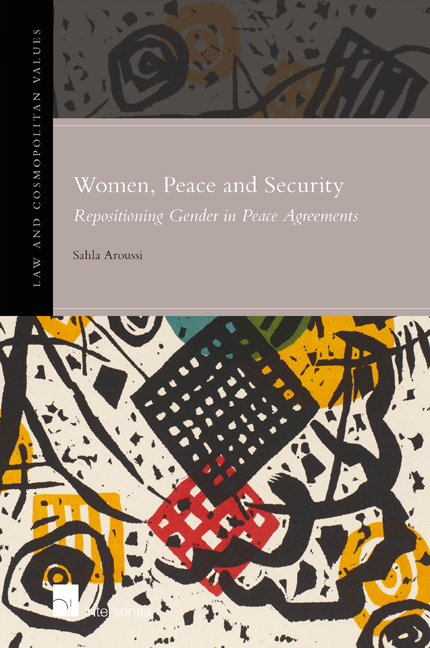Book contents
- Frontmatter
- Acknowledgements
- Contents
- List of Abbreviations
- List of Tables and Figures
- Introduction
- Chapter 1 The United Nations Resolutions on Women, Peace and Security
- Chapter 2 The Gender of Peace Agreements
- Chapter 3 Overview of Gender Provisions in Peace Agreements
- Chapter 4 Women's Political Participation in Peace Agreements
- Chapter 5 Gender-Based Violence
- Chapter 6 Perspectives from the Field
- Conclusion
- References
- Law and Cosmopolitan Values
- Instructions to authors
Chapter 1 - The United Nations Resolutions on Women, Peace and Security
Published online by Cambridge University Press: 12 December 2017
- Frontmatter
- Acknowledgements
- Contents
- List of Abbreviations
- List of Tables and Figures
- Introduction
- Chapter 1 The United Nations Resolutions on Women, Peace and Security
- Chapter 2 The Gender of Peace Agreements
- Chapter 3 Overview of Gender Provisions in Peace Agreements
- Chapter 4 Women's Political Participation in Peace Agreements
- Chapter 5 Gender-Based Violence
- Chapter 6 Perspectives from the Field
- Conclusion
- References
- Law and Cosmopolitan Values
- Instructions to authors
Summary
This chapter sets the background for the study. The chapter starts by highlighting the gendered experiences of women in conflicts and the challenges that they face in the aftermath. The chapter briefly discusses the United Nation's previous work on women's rights and the limitations of this framework in the context of armed conflicts. The chapter then describes the background of the adoption of Security Council resolution 1325 on women, peace, and security. In particular, the chapter underscores the importance of the recent developments in international relations and the crucial role played by international feminist advocacy networks in the process leading up to the adoption of the first resolution on WPS. The final two sections of the chapter discuss the significance of the UN agenda on WPS and provide a detailed overview of the issues that it addresses.
THE EXPERIENCES OF WOMEN IN ARMED CONFLICTS
Armed conflicts undoubtedly have devastating effects on both women and men, but women's experiences of conflict are considerably different. This dissimilarity is arguably due to sexual violence, to women's reproductive abilities, to their roles as the primary caretakers in families, and their second class status in most conflict zones. During conflicts women are particularly targeted for sexual violence. Within the literature on women and war one finds incontrovertible testimonies as to the endemic nature of wartime sexual violence in countries as diverse as Syria; Sri Lanka; Democratic Republic of Congo; Uganda; Liberia; Sierra Leone; Sudan; Rwanda; Somalia; Haiti; Guatemala; El Salvador; Kosovo and Chechnya.
During conflicts, women also experience ‘economic violence’. On a global level the majority of women live in low income or middle income countries with only 15% of the world's female population living in high income countries.
In most of these societies female headed households are among the poorest with women making up the majority of the people at the bottom of the socio-economic ladder. Discrimination, illiteracy, lack of access to education and employment opportunities all contribute to women's economic subordination and poverty. The violence and insecurity during conflicts push women further into dire economic situations. Women, particularly those who have lost their male relatives, are more likely to be dispossessed and stripped of their land and properties.
- Type
- Chapter
- Information
- Women, Peace, and SecurityRepositioning gender in peace agreements, pp. 9 - 46Publisher: IntersentiaPrint publication year: 2015
- 1
- Cited by



